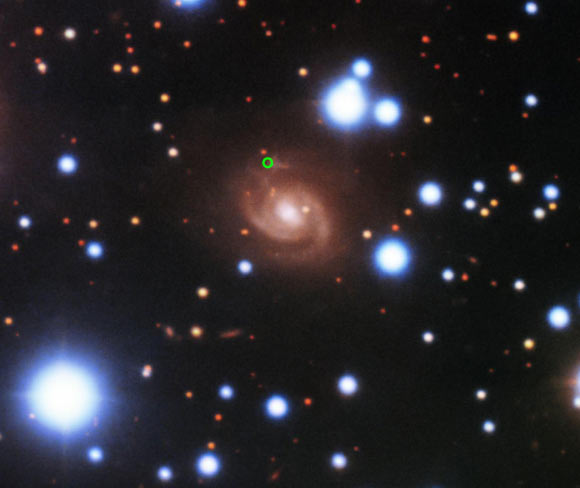Repeating Fast Radio Burst Localized to Massive Spiral Galaxy | Astronomy – Sci-News.com
Astronomers have pinpointed the source galaxy of the fast radio burst known as FRB 180916.J0158+65 (FRB 180916 for short) — making it the closest known example to us and only the second repeating fast radio burst source to have its location pinpointed in the sky.

This image from the 8-m Gemini North telescope shows SDSS J015800.28+654253.0 (center), the host galaxy of FRB 180916 (green circle). Image credit: Gemini Observatory / NSF’s National Optical-Infrared Astronomy Research Laboratory / AURA.
Fast radio bursts (FRBs) are mysterious bursts of energy from space. They have durations of milliseconds and exhibit the characteristic dispersion sweep of radio pulsars.
These events emit as much energy in one millisecond as the Sun emits in 10,000 years, but the physical phenomenon that causes them is unknown.
“There are two primary types of fast radio bursts: repeaters, which flash multiple times, and non-repeaters, one-off events,” said Kshitij Aggarwal, a graduate student at West Virginia University.
Despite the hundreds of records of these mysterious sources, astronomers have only pinpointed the precise location of four such bursts. Now there’s a fifth: FRB 180916.
“This observation marks only the second time scientists have determined the location of a repeating fast radio burst,” Aggarwal said.
In June 2019, the astronomers used eight telescopes of the European VLBI Network to observe FRB 180916, which was originally discovered by the CHIME (Canadian Hydrogen Intensity Mapping Experiment) telescope in British Columbia in 2018.
They detected four radio bursts, each lasting for less than two thousandths of a second.
Using a technique known as Very Long Baseline Interferometry (VLBI), they achieved a level of resolution high enough to localize these bursts to a region approximately 7 light-years across.
Follow-up observations with one of the world’s largest optical telescopes, the 8-m Gemini North on Mauna Kea in Hawaii, revealed that the bursts originated from a star-forming region in SDSS J015800.28+654253.0, a massive spiral galaxy located 500 million light-years from Earth.
“This galaxy is around 7 times closer than the only other repeating burst to have been localized, and more than 10 times closer than any of the few non-repeating FRBs scientists have managed to pinpoint,” the researchers noted.
“We used the 8-m Gemini North telescope to take sensitive images that showed the faint spiral arms of a Milky-Way-like galaxy and showed that the FRB source was in a star-forming region in one of those arms,” said Dr. Shriharsh Tendulkar, an astronomer at McGill University.
“This is a very different environment for a repeating FRB, compared to the dwarf galaxy in which the first repeating FRB 121102 was discovered to reside.”
“This is the closest FRB to Earth ever localized,” said Dr. Benito Marcote, an astronomer at the Joint Institute for VLBI European Research Infrastructure Consortium.
“Surprisingly, it was found in an environment radically different from that of the previous four localized FRBs — an environment that challenges our ideas of what the source of these bursts could be.”
The scientists hope that further studies will reveal the conditions that result in the production of these mysterious transient radio pulses, and address some of the many unanswered questions they pose.
“We have a new chance to perhaps detect emissions at other wavelengths — X-ray or visible light, for instance. And if we did, that would be hugely constraining of the models,” said Dr. Victoria Kaspi, an astrophysicist at McGill University and a leading member of the CHIME/FRB Collaboration.
“Our aim is to precisely localize more FRBs and, ultimately, understand their origin,” said Dr. Jason Hessels, an astronomer at the Netherlands Institute for Radio Astronomy (ASTRON) and the University of Amsterdam.
The findings were published in the January 9, 2020 issue of the journal Nature.
_____
B. Marcote et al. 2020. A repeating fast radio burst source localized to a nearby spiral galaxy. Nature 577, 190-194; doi: 10.1038/s41586-019-1866-z






